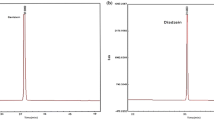Abstract
Antioxidants, chelators, and alcohols were screened at 0.01 and 1.28% by weight for their ability to delay viscosity increase in soybean oil in the presence of metallic colloidal copper and iron at 105°C with air flowing through the sample. Most substances did not significantly enhance the effect of the natural tocopherols in the soybean oil at 0.01%. A few substances were mildly prooxidant, and a few delayed the increase in viscosity significantly. TBHQ at 0.01% was the best antioxidant of those tested. At 1.28% ascorbyl palmitate, BHT, hydroquinone, and TBHQ increased the stability significantly. Again, TBHQ was the most effective. As measured by viscosity increase to 150 CP, TBHQ increased stability about five times over that of soybean oil controls.
Similar content being viewed by others
References
Johnson, D., Update on the Soybean Engine Oil Project, Paper presented at Lubricants and Fluids Technical Advisory Panel, Omnitech, Midland, MI, 1998.
Lambert, J.W., and D.L. Johnson, Vegetable Oil Lubricants for Internal-Combustion Engines and Total Loss Lubrication, U.S. Patent Application 97-912130 (1999).
Erhan, S.Z., and S. Asadauskas, Lubricant Basestocks from Vegetable Oils, Ind. Crops Prod. 11:277–282 (2000).
Asadauskas, S., and S.Z. Erhan, Thin-Film Test to Investigate Liquid Oxypolymerization of Nonvolatile Analytes: Assessment of Vegetable Oils and Biodegradable Lubricants, J. Am. Oil Chem. soc. 78:1029–1035 (2001).
Adhvaryu, A., S.Z. Erhan, Z.S. Liu, and J.M. Perez, Oxidation Kinetic Studies of Oils Derived from Unmodified and Genetically Modified Vegetables Using Pressurized Differential Scanning Calorimetry and Nuclear Magnetic Resonance Spectroscopy, Thermochim. Acta 364:87–97 (2000).
Official Methods and Recommended Practices of the American Oil Chemists’ Society, 4th edn., American Oil Chemists’ Society, Champaign, 1989, Cd 12-57.
Mounts, T.L., K.A. Warner, G.R. List, J.P. Fredrich, and S. Koritala, Flavor and Oxidative Stability of Hydrogenated and Unhydrogenated Soybean Oils: Effects of Antioxidants, J. Am. Oil Chem. Soc. 55:345–349 (1978).
Pokorný, J., Major Factors Affecting the Autoxidation of Lipids, in Autoxidation of Unsaturated Lipids, edited by H.W.-S. Chan, Academic Press, New York, 1987, pp. 141–206.
Frankel, E.N., Soybean Oil Flavor Stability, in Handbook of Soy Oil Processing and Utilization, edited by D.R. Erickson, E.H. Pryde, O.L. Brekke, T.L. Mounts, and R.A. Falb, American Oil Chemists’ Society, Champaign, 1980, pp. 229–244.
Pryde, E.H., Composition of Soybean Oil, in Handbook of Soy Oil Processing and Utilization, edited by D.R. Erickson, E.H. Pryde, O.L. Brekke, T.L. Mounts, and R.A. Falb, American Oil Chemists’ Society, Champaign, 1980, pp. 13–31.
Kortenska, V.D., and N.V. Yanishlieva, Effect of the Phenol Antioxidant Type on the Kinetics and Mechanism of Inhibited Lipid Oxidation in the Presence of Fatty Alcohols, J. Sci. Food Agric. 68:117–126 (1995).
Author information
Authors and Affiliations
Corresponding author
About this article
Cite this article
Ruger, C.W., Klinker, E.J. & Hammond, E.G. Abilities of some antioxidants to stabilize soybean oil in industrial use conditions. J Amer Oil Chem Soc 79, 733–736 (2002). https://doi.org/10.1007/s11746-002-0550-2
Received:
Accepted:
Issue Date:
DOI: https://doi.org/10.1007/s11746-002-0550-2



